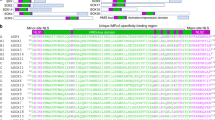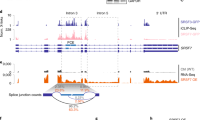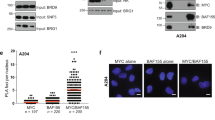Abstract
Smad proteins are a class of tumor suppressors that play critical roles in inhibiting the proliferation of a variety of cell types by modulating the transcriptions of target genes. Despite recent advances, the mechanism of their nuclear import is not completely understood. Smad proteins contain a conserved basic motif in their N-terminal MH1 domains that resembles a nuclear localization signal (NLS). Previous studies indicate that in receptor-regulated Smads such as Smad1 and Smad3 this motif determines their interactions with nuclear import receptors and mediates their ligand-induced nuclear translocation. Common-Smads such as Smad4 display constant nucleocytoplasmic shuttling and are capable of autonomous nuclear import and export. Mutations of the basic motif in Smad4 disrupted its nuclear accumulation. However, this motif is not sufficient to confer nuclear translocation to a fused heterologous protein, suggesting that it is only part of the bona fide Smad4 NLS. We mapped the Smad4 NLS by fusing various segments of Smad4 sequence covering the basic motif to GFP and tested the localization of the fusion proteins. We identified an extended NLS, starting from the basic motif and extending into the DNA-binding region (AA 45–110), that is sufficient to confer nuclear localization to GFP. Among the 14 basic residues in the NLS, only four (K45, K46, K48 and R81) are critical for import. This NLS is critical not only for autonomous nuclear import of Smad4, but also for its nuclear translocation in the presence of activated R-Smads, further confirming the functional relevance of the Smad4 NLS in TGF-β signal transduction. Structural modeling demonstrated that the four critical basic residues are all solvent exposed and map to a single localized segment on one surface of the Smad4 MH1 domain. Their distribution and spacing resemble a classical bipartite NLS. Smad4 displays specific binding to importin α through its MH1 domain, which was abrogated by loss-of-function mutations in Smad4 NLS. Finally, the Smad4 NLS is essential for its transcriptional activity since loss-of-function NLS mutants are also transcriptionally inactive.
This is a preview of subscription content, access via your institution
Access options
Subscribe to this journal
Receive 50 print issues and online access
$259.00 per year
only $5.18 per issue
Buy this article
- Purchase on Springer Link
- Instant access to full article PDF
Prices may be subject to local taxes which are calculated during checkout








Similar content being viewed by others
References
de Caestecker MP, Yahata T, Wang D, Parks WT, Huang S, Hill CS, Shioda T, Roberts AB and Lechleider RJ . (2000). J. Biol. Chem., 275, 2115–2122.
Conti E, Uy M, Leighton L, Blobel G and Kuriyan J . (1998). Cell, 94, 193–204.
Gorlich D and Mattaj IW . (1996). Science, 271, 1513–1518.
Hanyu A, Ishidou Y, Ebisawa T, Shimanuki T, Imamura T and Miyazono K . (2001). J. Cell Biol., 155, 1017–1027.
Jones JB and Kern SE . (2000). Nucleic Acids Res., 28, 2363–2368.
Kobe B . (1999). Nat. Struct. Biol., 6, 388–397.
Kurisaki A, Kose S, Yoneda Y, Heldin CH and Moustakas A . (2001). Mol. Biol. Cell., 12, 1079–1091.
Liu F, Pouponnot C and Massague J . (1997). Genes Dev. 11, 3157–3167.
Massague J and Wotton D . (2000). EMBO J., 19, 1745–1754.
Moren A, Itoh S, Moustakas A, Dijke P and Heldin CH . (2000). Oncogene, 19, 4396–4404.
Nicols A, Sharkp KA and Honig B . (1991). Proteins, 11, 140–163.
Pierreux CE, Nicolas FJ and Hill CS . (2000). Mol. Cell. Biol., 20, 9041–9054.
Sali A and Blundell T . (1993). J. Mol. Biol., 234, 779–815.
Sekimoto T, Imamoto N, Nakajima K, Hirano T and Yoneda Y . (1997). EMBO J., 16, 7067–7077.
Shi Y, Wang YF, Jayaraman L, Yang H, Massague J and Pavletich NP . (1998). Cell, 94, 585–594.
Watanabe MN, Masuyama M, Fukuda K and Nishida E . (2000). EMBO Rep., 1, 176–182.
Wu RY, Zhang Y, Feng XH and Derynck R . (1997). Mol. Cell Biol., 17, 2521–2528.
Xiao Z, Liu X, Henis YI and Lodish HF . (2000a). Proc. Natl. Acad. Sci. USA, 97, 7853–7858.
Xiao Z, Liu X and Lodish HF . (2000b). J. Biol. Chem., 275, 23425–23428.
Xu J and Attisano L . (2000). Proc. Natl. Acad. Sci. USA, 97, 4820–4825.
Ying X and Dong X . (2000). Proteins: Struct. Function Genet., 40, 343–354.
Acknowledgements
We thank members of the Lodish group for stimulating discussions. We thank Dr M Yoshida (The University of Tokyo, Japan) for providing Leptomycin B (LMB). This work was supported by National Institutes of Health grant CA63260 to HFL and by a postdoctoral fellowship from the Damon Runyon – Walter Winchell Cancer Research Foundation to ZX.
Author information
Authors and Affiliations
Corresponding author
Rights and permissions
About this article
Cite this article
Xiao, Z., Latek, R. & Lodish, H. An extended bipartite nuclear localization signal in Smad4 is required for its nuclear import and transcriptional activity. Oncogene 22, 1057–1069 (2003). https://doi.org/10.1038/sj.onc.1206212
Received:
Revised:
Accepted:
Published:
Issue Date:
DOI: https://doi.org/10.1038/sj.onc.1206212
Keywords
This article is cited by
-
Smad4 regulates the nuclear translocation of Nkx2-5 in cardiac differentiation
Scientific Reports (2021)
-
Eribulin rapidly inhibits TGF-β-induced Snail expression and can induce Slug expression in a Smad4-dependent manner
British Journal of Cancer (2019)
-
Nuclear Localization of the DNA Repair Scaffold XRCC1: Uncovering the Functional Role of a Bipartite NLS
Scientific Reports (2015)
-
The Role of Endocytic Pathways in TGF-β Signaling
Pathology & Oncology Research (2013)
-
Role of Smads in TGFβ signaling
Cell and Tissue Research (2012)



